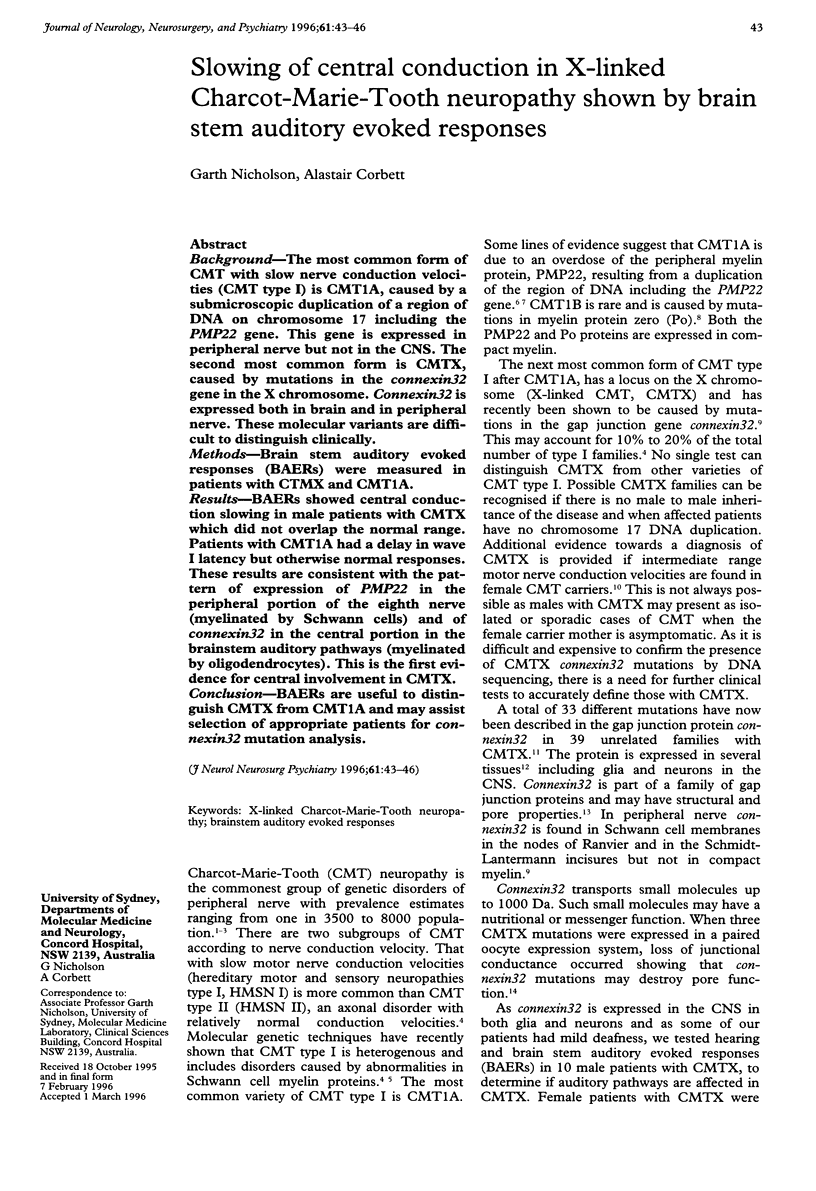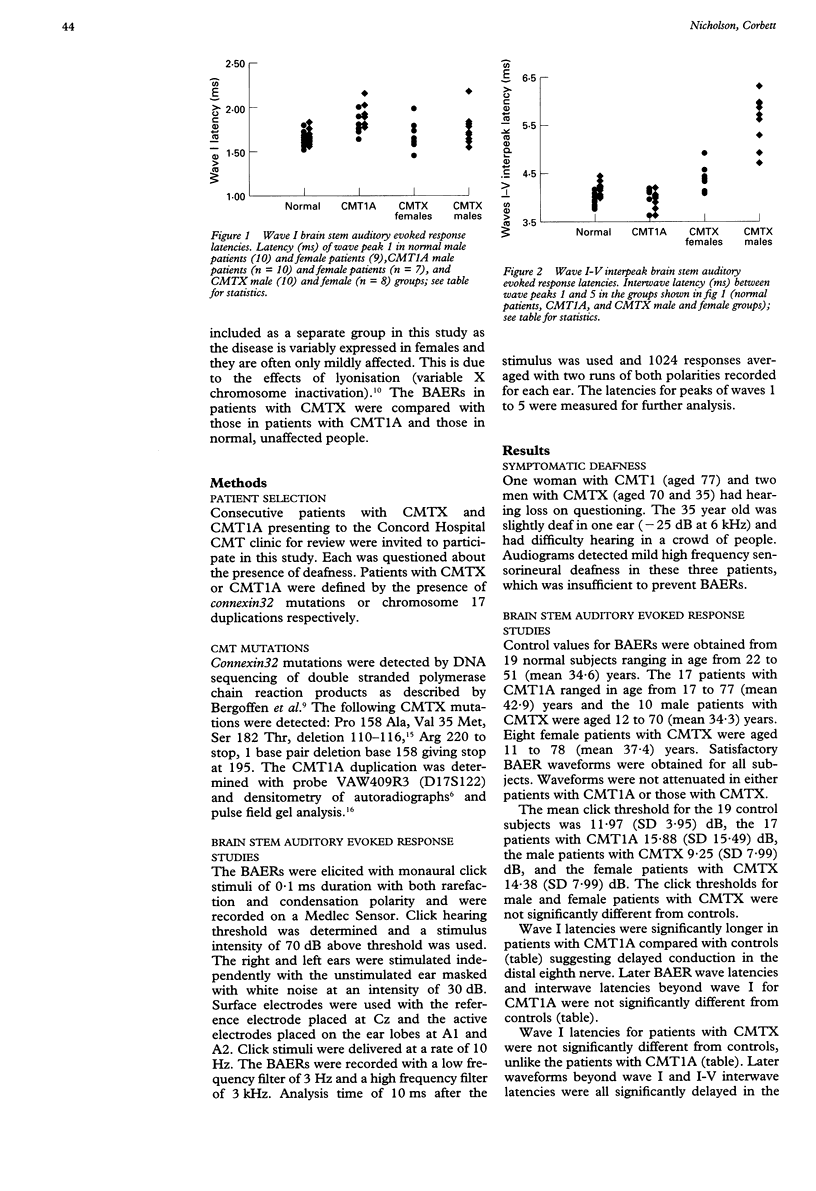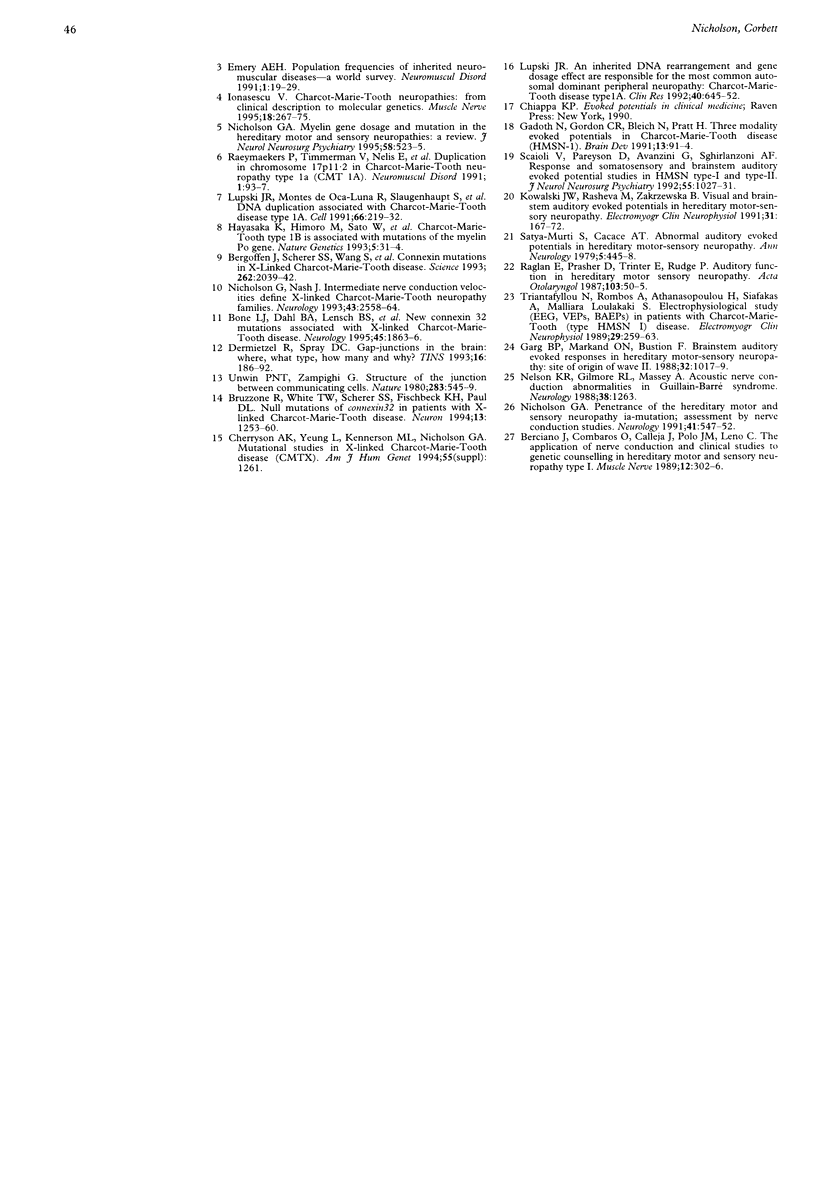Abstract
BACKGROUND--The most common form of CMT with slow nerve conduction velocities (CMT type I) is CMT1A, caused by a submicroscopic duplication of a region of DNA on chromosome 17 including the PMP22 gene. This gene is expressed in peripheral nerve but not in the CNS. The second most common form is CMTX, caused by mutations in the connexin32 gene in the X chromosome. Connexin32 is expressed both in brain and in peripheral nerve. These molecular variants are difficult to distinguish clinically. METHODS--Brain stem auditory evoked responses (BAERs) were measured in patients with CTMX and CMT1A. RESULTS--BAERs showed central conduction slowing in male patients with CMTX which did not overlap the normal range. Patients with CMT1A had a delay in wave I latency but otherwise normal responses. These results are consistent with the pattern of expression of PMP22 in the peripheral portion of the eighth nerve (myelinated by Schwann cells) and of connexin32 in the central portion in the brainstem auditory pathways (myelinated by oligodendrocytes). This is the first evidence for central involvement in CMTX. CONCLUSION--BAERs are useful to distinguish CMTX from CMT1A and may assist selection of appropriate patients for connexin32 mutation analysis.
Full text
PDF



Selected References
These references are in PubMed. This may not be the complete list of references from this article.
- Berciano J., Combarros O., Calleja J., Polo J. M., Leno C. The application of nerve conduction and clinical studies to genetic counseling in hereditary motor and sensory neuropathy type I. Muscle Nerve. 1989 Apr;12(4):302–306. doi: 10.1002/mus.880120408. [DOI] [PubMed] [Google Scholar]
- Bergoffen J., Scherer S. S., Wang S., Scott M. O., Bone L. J., Paul D. L., Chen K., Lensch M. W., Chance P. F., Fischbeck K. H. Connexin mutations in X-linked Charcot-Marie-Tooth disease. Science. 1993 Dec 24;262(5142):2039–2042. doi: 10.1126/science.8266101. [DOI] [PubMed] [Google Scholar]
- Bone L. J., Dahl N., Lensch M. W., Chance P. F., Kelly T., Le Guern E., Magi S., Parry G., Shapiro H., Wang S. New connexin32 mutations associated with X-linked Charcot-Marie-Tooth disease. Neurology. 1995 Oct;45(10):1863–1866. doi: 10.1212/wnl.45.10.1863. [DOI] [PubMed] [Google Scholar]
- Bruzzone R., White T. W., Scherer S. S., Fischbeck K. H., Paul D. L. Null mutations of connexin32 in patients with X-linked Charcot-Marie-Tooth disease. Neuron. 1994 Nov;13(5):1253–1260. doi: 10.1016/0896-6273(94)90063-9. [DOI] [PubMed] [Google Scholar]
- Dermietzel R., Spray D. C. Gap junctions in the brain: where, what type, how many and why? Trends Neurosci. 1993 May;16(5):186–192. doi: 10.1016/0166-2236(93)90151-b. [DOI] [PubMed] [Google Scholar]
- Emery A. E. Population frequencies of inherited neuromuscular diseases--a world survey. Neuromuscul Disord. 1991;1(1):19–29. doi: 10.1016/0960-8966(91)90039-u. [DOI] [PubMed] [Google Scholar]
- Gadoth N., Gordon C. R., Bleich N., Pratt H. Three modality evoked potentials in Charcot-Marie-Tooth disease (HMSN-1). Brain Dev. 1991;13(2):91–94. doi: 10.1016/s0387-7604(12)80113-6. [DOI] [PubMed] [Google Scholar]
- Garg B. P., Markand O. N., Bustion P. F. Brainstem auditory evoked responses in hereditary motor-sensory neuropathy: site of origin of wave II. Neurology. 1982 Sep;32(9):1017–1019. doi: 10.1212/wnl.32.9.1017. [DOI] [PubMed] [Google Scholar]
- Hayasaka K., Himoro M., Sato W., Takada G., Uyemura K., Shimizu N., Bird T. D., Conneally P. M., Chance P. F. Charcot-Marie-Tooth neuropathy type 1B is associated with mutations of the myelin P0 gene. Nat Genet. 1993 Sep;5(1):31–34. doi: 10.1038/ng0993-31. [DOI] [PubMed] [Google Scholar]
- Ionasescu V. V. Charcot-Marie-Tooth neuropathies: from clinical description to molecular genetics. Muscle Nerve. 1995 Mar;18(3):267–275. doi: 10.1002/mus.880180302. [DOI] [PubMed] [Google Scholar]
- Kowalski J. W., Rasheva M., Zakrzewska B. Visual and brainstem auditory evoked potentials in hereditary motor-sensory neuropathy. Electromyogr Clin Neurophysiol. 1991 Apr;31(3):167–172. [PubMed] [Google Scholar]
- Lupski J. R. An inherited DNA rearrangement and gene dosage effect are responsible for the most common autosomal dominant peripheral neuropathy: Charcot-Marie-Tooth disease type 1A. Clin Res. 1992 Dec;40(4):645–652. [PubMed] [Google Scholar]
- Lupski J. R., de Oca-Luna R. M., Slaugenhaupt S., Pentao L., Guzzetta V., Trask B. J., Saucedo-Cardenas O., Barker D. F., Killian J. M., Garcia C. A. DNA duplication associated with Charcot-Marie-Tooth disease type 1A. Cell. 1991 Jul 26;66(2):219–232. doi: 10.1016/0092-8674(91)90613-4. [DOI] [PubMed] [Google Scholar]
- MacMillan J. C., Harper P. S. The Charcot-Marie-Tooth syndrome: clinical aspects from a population study in South Wales, UK. Clin Genet. 1994 Mar;45(3):128–134. doi: 10.1111/j.1399-0004.1994.tb04009.x. [DOI] [PubMed] [Google Scholar]
- Nelson K. R., Gilmore R. L., Massey A. Acoustic nerve conduction abnormalities in Guillain-Barré syndrome. Neurology. 1988 Aug;38(8):1263–1266. doi: 10.1212/wnl.38.8.1263. [DOI] [PubMed] [Google Scholar]
- Nicholson G. A. Penetrance of the hereditary motor and sensory neuropathy Ia mutation: assessment by nerve conduction studies. Neurology. 1991 Apr;41(4):547–552. doi: 10.1212/wnl.41.4.547. [DOI] [PubMed] [Google Scholar]
- Nicholson G. Myelin gene dosage and mutation in the hereditary motor and sensory neuropathies: a review. J Neurol Neurosurg Psychiatry. 1995 May;58(5):523–525. doi: 10.1136/jnnp.58.5.523. [DOI] [PMC free article] [PubMed] [Google Scholar]
- Nicholson G., Nash J. Intermediate nerve conduction velocities define X-linked Charcot-Marie-Tooth neuropathy families. Neurology. 1993 Dec;43(12):2558–2564. doi: 10.1212/wnl.43.12.2558. [DOI] [PubMed] [Google Scholar]
- Raeymaekers P., Timmerman V., Nelis E., De Jonghe P., Hoogendijk J. E., Baas F., Barker D. F., Martin J. J., De Visser M., Bolhuis P. A. Duplication in chromosome 17p11.2 in Charcot-Marie-Tooth neuropathy type 1a (CMT 1a). The HMSN Collaborative Research Group. Neuromuscul Disord. 1991;1(2):93–97. doi: 10.1016/0960-8966(91)90055-w. [DOI] [PubMed] [Google Scholar]
- Raglan E., Prasher D. K., Trinder E., Rudge P. Auditory function in hereditary motor and sensory neuropathy (Charcot-Marie-Tooth disease). Acta Otolaryngol. 1987 Jan-Feb;103(1-2):50–55. doi: 10.3109/00016488709134697. [DOI] [PubMed] [Google Scholar]
- Satya-Murti S., Cacace A. T., Hanson P. A. Abnormal auditory evoked potentials in hereditary motor-sensory neuropathy. Ann Neurol. 1979 May;5(5):445–448. doi: 10.1002/ana.410050506. [DOI] [PubMed] [Google Scholar]
- Scaioli V., Pareyson D., Avanzini G., Sghirlanzoni A. F response and somatosensory and brainstem auditory evoked potential studies in HMSN type I and II. J Neurol Neurosurg Psychiatry. 1992 Nov;55(11):1027–1031. doi: 10.1136/jnnp.55.11.1027. [DOI] [PMC free article] [PubMed] [Google Scholar]
- Skre H. Genetic and clinical aspects of Charcot-Marie-Tooth's disease. Clin Genet. 1974;6(2):98–118. doi: 10.1111/j.1399-0004.1974.tb00638.x. [DOI] [PubMed] [Google Scholar]
- Triantafyllou N., Rombos A., Athanasopoulou H., Siafakas A., Loulakaki S. M. Electrophysiological study (EEG, VEPs, BAEPs) in patients with Charcot Marie Tooth (type HMSN I) disease. Electromyogr Clin Neurophysiol. 1989 Jul-Aug;29(5):259–263. [PubMed] [Google Scholar]
- Unwin P. N., Zampighi G. Structure of the junction between communicating cells. Nature. 1980 Feb 7;283(5747):545–549. doi: 10.1038/283545a0. [DOI] [PubMed] [Google Scholar]


